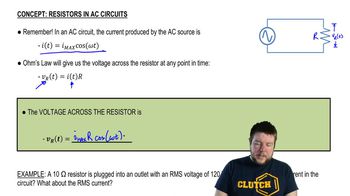Multiple Choice
An inductor, a capacitor, and a resistor are in series with a AC source with peak voltage 13 V. If the impedance of the circuit is , what is the peak current?
840
views
 Verified step by step guidance
Verified step by step guidance Verified video answer for a similar problem:
Verified video answer for a similar problem:



 5:55m
5:55mMaster LRC Circuits in Series with a bite sized video explanation from Patrick
Start learning